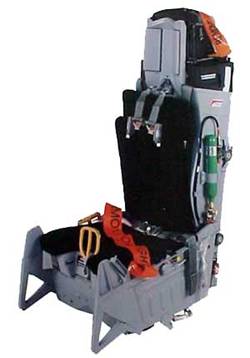





Published on Feb 14, 2025
Almost since the first days of flight man has been concerned with the safe escape from an aircraft which was no longer flyable. Early escape equipment consisted of a recovery parachute only.
As aircraft performance rapidly increased during World War II, it became necessary to assist the crewmen in gaining clear safe separation from the aircraft. This was accomplished with an ejector seat which was powered by a propellant driven catapult - the first use of a propulsive element in aircrew escape.
Since then, this collection of componentry has evolved through several generations into today's relatively complex systems which are highly dependent upon propulsive elements. Ejection seats are one of the most complex pieces of equipment on any aircraft, and some consist of thousands of parts. The purpose of the ejection seat is simple: To lift the pilot straight out of the aircraft to a safe distance, then deploy a parachute to allow the pilot to land safely on the ground.
The first operational use of a propulsive element to assist an aircrew to escape from an aircraft apparently occurred during World War II. It appears that the country to receive credit for the first operational system was Germany, as it is known that approximately 60 successful ejections were made from German aircraft during World War II. It is interesting to note, however, that the first aircraft ejection seat was designed and tested (successfully) with a dummy in 1910 by J. S. Zerbe in Los Angeles, California.
This was one year before the first parachutist successfully, jumped from an aircraft. Another country involved in early ejection seat work was Sweden. Initial experiments were made by SAAB in 1942 using propellant powered seats. The first successful dummy in-flight ejection was on 8 January 1942. A successful live ejection was made on 29 July 1946.At the end of World War II both the British and Americans acquired German and Swedish ejection seats and data. This information and equipment added impetus to their efforts.
The first live flight test in England occurred on 24 July 1946 when Mr. Bernard Lynch ejected from a Meteor III aircraft at 320 mph IAS at 8,000 feet, using a prototype propellant powered seat. On 17 August 1946 First Sergeant Larry Lambert ejected from a P61B at 300 mph IAS at 7,800 feet to become the first live in-flight US ejection test.
To understand how an ejection seat works, you must first be familiar with the basic components in any ejection system. Everything has to perform properly in a split second and in a specific sequence to save a pilot's life. If just one piece of critical equipment malfunctions, it could be fatal. Like any seat, the ejection seat's basic anatomy consists of the bucket, back and headrest. Everything else is built around these main components.
Here are key devices of an ejection seat:
• Catapult
• Rocket
• Restraints
• Parachute
This early propulsive element has been called a gun or catapult and, is in essence, a closed telescoping tube arrangement containing a propellant charge to forcibly extend the tubes, thereby imparting the necessary separation velocity to the "ejector seat" and its contents .The rocket is a propulsive device in the seat. The catapult remained as the initial booster to get the seat/man mass clear of the cockpit, while the rocket motor came on line, once clear of the cockpit, to act in a sustainer mode.
The restraint system for the crue member is the protective devices to avoid injury while ejecting the seat. Harness straps can be tightened and body position can be adjusted to reduce injury from the forces encountered during ejection. Leg lifting devices and arm and leg restraints are provided to prevent limb flail injuries due to windblast forces. The limb restraints do not require the crew to hook up as they enter the aircraft and do not restrict limb movement during normal flight operations. Parachute helped the pilot to land safely on ground.
The Advanced Concept Ejection Seat (ACES) was designed to be rugged and lightweight compared to earlier systems. It also was designed to be easy to maintain and updatable.
It includes the following features:
• Electronic Sequencing and timing
• Auto sensing of egress conditions
• Parachute reefing to control opening at all speed ranges
• Multi-Mode operation for optimum recovery of the crewman

The ACES II is a third-generation seat, capable of ejecting a pilot from zero-zero conditions up to maximum altitude and airspeeds in the 250 knots (288 mph / 463 kph) range. The peak catapult acceleration is about 12gz. The ACES II has three main operating modes, one each for the low speed/low altitude, medium speed, and high speed/high altitude.
• Mode 1: low altitude, low speed - Mode 1 is for ejections at speeds of less than 250 knots (288 mph / 463 kph) and altitudes of less than 15,000 feet (4,572 meters). The drogue parachute doesn't deploy in mode 1.
• Mode 2: low altitude, high speed - Mode 2 is for ejections at speeds of more than 250 knots and altitudes of less than 15,000 feet.
• Mode 3: high altitude, any speed - Mode 3 is selected for any ejection at an altitude greater than 15,000 feet.
Deployment is delayed by the sequencer until the seat-man package reaches either Mode 2, or Mode 1 conditions, whichever comes first.
Seat modes are selected by the sequencer based on atmospheric conditions, and the modes vary depending on differences in the conditions such as apparent airspeed and apparent altitude.
The Advanced Concept Ejection Seat (ACES) was designed to be rugged and lightweight compared to earlier systems. It also was designed to be easy to maintain and updatable
| Are you interested in this topic.Then mail to us immediately to get the full report.
email :- contactv2@gmail.com |